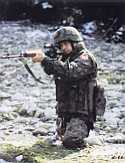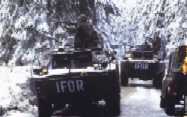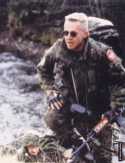 |
Vol 1, No 6, 2 August 1999
|
|
|
 K A R L O V Y V A R Y:
K A R L O V Y V A R Y:The Horrors of Heroism: Wladyslaw Pasikowski's Demony wojny wedlug Goi Andrew J Horton The title of the film Demony wojny wedlug Goi (Demons of War by Goya, 1998) is a reference to a series of etchings made in the early nineteenth century by the Spanish painter Francisco de Goya y Lucientes (1746 to 1828). After a relatively cosy life sucking up to the Spanish royal family with the airy and light portraits they commissioned from him, Goya's health took a turn for the worse. Faced with the spectre of death and now living in poverty, Goya's paintings became increasingly morbid, culminating in the famous "black paintings" on the wall of his French villa (they have since been transferred to the Museo del Prado in Madrid). Before then, his haunting visions also found outlets in his smaller scale etchings, many of which used pioneering techniques. One of these sets was the Disasters of War. Based on Goya's observations of the Franco-Spanish war in 1808, it depicted in graphic detail the full extent of man's inhumanity to man. Even with the multi-million-dollar budgets available to modern film directors for recreating the blood and gore of battle, Goya's etchings, made nearly 200 years ago, still remain the most powerful anti-war statement that the arts have managed to produce. Pasikowski's film is certainly not going to challenge the achievement of the old master. Flying bullets Demony follows an IFOR peacekeeping force in Bosnia, with the action taking place in February 1996 as the war was coming to an end. The peacekeeping unit is commanded by Major Kellner - a hunky taciturn sort of commander who is under investigation for his part in saving a Polish mercenary from a lynching. With only hours remaining to Kellner's command, the base receives a call from a Norwegian chopper with Polish soldiers on board. Demony is obviously a high-budget affair, with impressive photography and a melodramatic orchestral score with lots of deep bass notes and booming kettle drums. Pasikowski has also employed three of the most famous Polish actors in the lead roles: Olaf Linde-Lubeszenko (A Short Film About Love, Schindler's List), Zbigniew Zamachowski (The Decalogue, Three Colours: White) and Boguslaw Linda (Man of Iron, The Decalogue) in the role of Major Kellner. These factors alone, independently of the merit of the film, are likely to make box office receipts high in Poland. However, the film is morally flawed. Goya's etchings were made for nobody and served merely as an outlet for the Demony (demons) which haunted him. Pasikowski's work is a cynical attempt to make money on the image of suffering. It is a sad reflection on the film that the most graphic sequences occur in the title sequence when Goya's images are montaged on top of a throbbing techno soundtrack. Pasikowski cares little about the true suffering that war causes and nil about the people of Bosnia. Although he certainly pauses to ask some pertinent questions about the role of peacekeepers and does show the panic and terror of the Polish soldiers, he shows little sensitivity to the fact that the war in Bosnia was about the rape of a nation. Dark shades - light stubble His film is primarily a vehicle for showing the dashing Boguslaw Linda off as a model of Polish masculinity. With his striking jawline, dark shades and light stubble, Linda certainly looks good in If there is death and suffering in the film, it is (almost) exclusively experienced by Poles. The only true sequence in which the inhabitants of Bosnia are shown as victims of the war is in the film's climax. But even here, there is something remarkably shallow about the scene. The blazing flames of the torched village exist not so much as to demonstrate the terror inflicted on the villagers but more as a dramatic, blazing backdrop, against which Linda can have his final confrontation with his arch-enemy. A brief glimpse of a girl being raped is worryingly shown not in order for us to identify with her terrible fate but to justify Linda's violent retribution against the perpetrators. As such, Demony is a distinctly pro-war film. It fully supports Major Kellner's actions, including even the death of the troops under him, who have to die in order for him to achieve his personal glory. Whilst many films express the need for some to die in order to for a common goal to be won, few films go as far as advocating that it is necessary for soldiers to die in order to fulfil the heroic aspirations of their commander. This makes Demony a truly odious and insensitive piece of film-making. Of course, there are films around which glorify the actions of individuals in wars and situations of rather dubious moral justification. However, few of these films stoop quite so low as to adopt a title which suggests that they are anti-war films, as is the case with Demony - in its invocation of the spirit of Goya. Andrew J Horton, 22 July 1999Click HERE to read the second in this pair of articles: another conflict between "peacekeepers" and local guerrillas, this time in the Caucasus. Pasikowski's film seems an appropriate occasion to announce that in the last CER of 1999, Kinoeye will run a feature on the most politically incorrect Central European film of the year. It has been another strong year for films of dubious moral values (see past Kinoeye features), and I am sure the competition will be tough. I therefore welcome all nominations for this coveted title from Kinoeye readers. Any film can be recommended for the award, provided it is on the international festival circuit or on general local release in Central Europe this year. Also welcome by Kinoeye will be any further discussion, analysis or defences of films that have been slated on these pages. Send your nominations and/or comments HERE Kinoeye at Karlovy Vary The following is a list of other films shown at Karlovy Vary which have been covered by Kinoeye. Tockovi (Wheels) by Djordje Milosavljevic, Yugoslavia Gengszterfim (Gangster Film) by Gyorgy Szomjas, Hungary Nekem lampast adott kezembe as Ur Pesten (The Lord's Lantern in Budapest) by Miklos Jancso, Hungary Krava (The Cow) by Karel Kachyna, Czech Republic Okraina (Outskirts) by Peter Lutsik, Russia Pasti, pasti, pasticky (Traps) by Vera Chytilova, Czech Republic Kinai vedelem (Chinese Defence) by Gabor Tompa, Hungary
|
|
![]()
Copyright (c) 1999 - Central Europe Review Internet servis, a.s.
All Rights Reserved
 Breaking orders yet again, Kellner orders a rescue attempt for his imperilled compatriots. Major Kusz, soon to be his replacement, tags along so he can report on Kellner's reckless mission and shed light on his behaviour for the on-going investigation into his style of command. Although the soldier's fellow countrymen have all been killed, they do manage to rescue a French journalist, who attracts more attention from the guerrillas operating in the hills than seems normal to Kellner. He and the unit soon find themselves in the middle of political intrigue as well as flying bullets.
Breaking orders yet again, Kellner orders a rescue attempt for his imperilled compatriots. Major Kusz, soon to be his replacement, tags along so he can report on Kellner's reckless mission and shed light on his behaviour for the on-going investigation into his style of command. Although the soldier's fellow countrymen have all been killed, they do manage to rescue a French journalist, who attracts more attention from the guerrillas operating in the hills than seems normal to Kellner. He and the unit soon find themselves in the middle of political intrigue as well as flying bullets. uniform, and his maverick attitude and selfless heroism make him an ideal film hero. Linda in the role of Kellner is indisputably the subject of the film and the demons of war are curiously absent.
uniform, and his maverick attitude and selfless heroism make him an ideal film hero. Linda in the role of Kellner is indisputably the subject of the film and the demons of war are curiously absent.